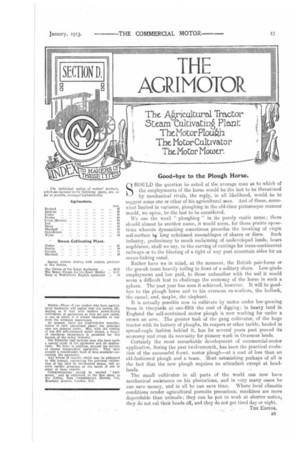THE AGRI MOTOR
Page 65

If you've noticed an error in this article please click here to report it so we can fix it.
Good-bye to the Plough Horse.
HOULD the question be asked of the average man as to which of k. the employments of the horse would be the last to be threatened by mechanical rivals, the reply, in all likelihood, would be to suggest some one or other of his agricultural uses. And of these, somewhat limited in variance, ploughing in the old-time picturesque manner would, we opine, be the last to he considered. We use the woyd " ploughing " in its purely rustic sense ; there should almost be another name, it would seem, for those prairie opeyations wherein dynamiting sometimes precedes the breaking of virgin soil-surface bf long echeloned assemblages of shares or discs. Such industry, preliminary to much reclaiming of undeveloped lands, bears semblance, shall we say, to the carving of cuttings for trans-continental railways or to the blasting of a right, of way past mountain sides for an ocean-linking canal.
Rather have we in mind, at the moment, the British pair-borse or the gee-oh team heavily toiling in front of a solitary share. Low-grade employment and low paid, to those unfamiliar with the soil it would seem a difficult feat to challenge the economy of the horse in such a pli.ere. The past year has seen it achieved, however. It will be goodbye to the plough horse and to his overseas co-workers, the bullock, the camel, and, maybe, the elephant.
It is actually possible now to cultivate by motor under low-growing trees in vineyards at one-fifth the cost of digging ; in heavy land in England the self-contained motor plough is now working for under a crown an acre. The greater task of the gang cultivator, of the huge tractor with its battery of ploughs, its reapers or other tackle, hauled in spread-eagle fashion behind it, has for several years past proved its economy and even its necessity for pioneer work in Overseas lands.
Certainly the most remarkable development of commercial-motor application, during the past twelvemonth, has been the practical evolution of the successful 6-cwt. mot-or plough—at a cost of less than an okl-fashioned plough and a team. Most astonishing perhaps of all is the fact that the new plough requires no attendant except at head lands. ..
The small cultivator in all parts of the World can now have mechanical assistance on his plantations, and in very many cases he can save money, and in all he can save time. Where local climatic conditions render agricultural pursuits precarious, machines are more dependable than animals; they can be put to work at shorter notice, they do not eat their heads off, and they do not get tired day or night. '
• THE EDITOR.


























































































